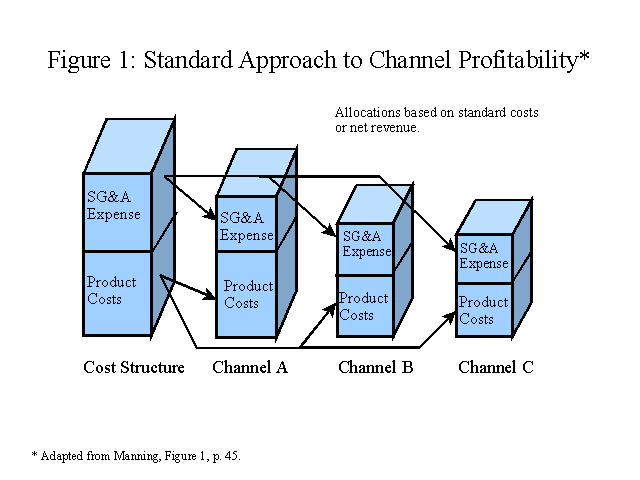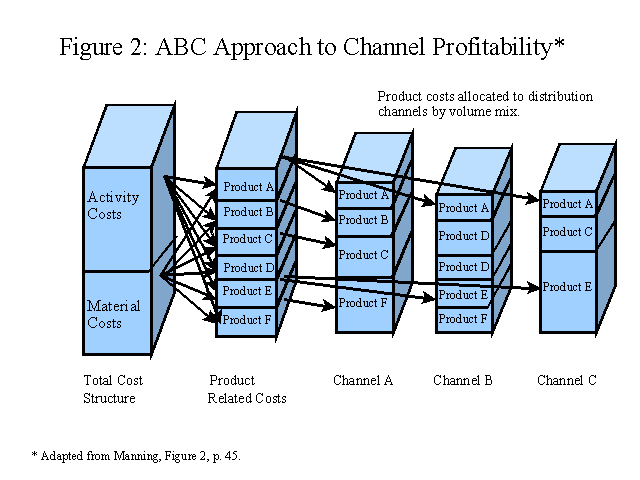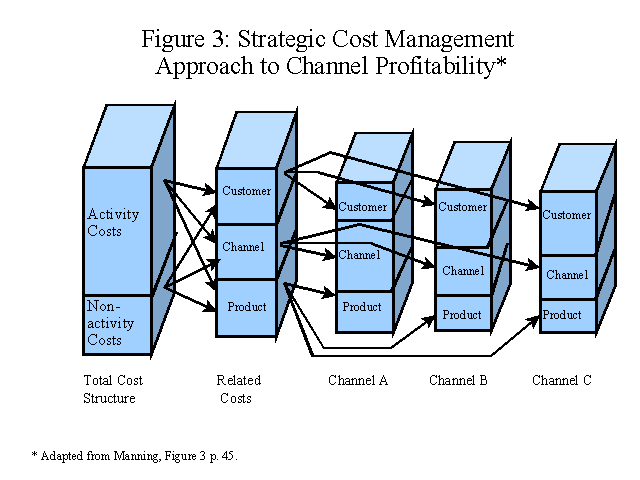
Summary by Kevin Wrobel
Master of Accountancy Program
University of South Florida, Summer 2002
ABC Main Page | Customer
Profitability Main Page | Logistics and Distribution Cost Main Page
The purpose of this article is to compare the methods of determining distribution channel profitability. The author compares standard costing, activity based costing, and strategic cost management methods to analyze the profitability of distribution channels.
The Standard Costing Method
Product costs, and selling, general and administrative (SG&A) costs are the two pools used for this method. SG&A costs are allocated to the channels based on the net revenues of the respective channels. This method is useful if the organization is aligned by channel or customer group, but these scenarios are not very realistic. The standard costing method to determine channel profitability has all the same drawbacks as traditional standard product costing, which tends to distort cost. See Figure 1 for a graphic illustration of the standard cost method.
Activity Based Costing
The ABC method is more accurate at tracing costs to products, but is based on the assumption that all costs are product driven. However, channel costs and profitability are not typically driven solely by products, but also by the customers served and the channels through which the products are provided. Therefore, the ABC approach is not the best method to determine channel profitability. See Figure 2 for a graphic view of the ABC approach as described by Manning.

Strategic Cost Management (SCM)
SCM recognizes that costs are not driven solely by products produced, but also by the customers served and the channels through which the products are sold (e.g., distributors, catalogs, mega-stores, direct mail, e-commerce, etc.). This method separates costs into three different types: product-related costs, channel-related costs, and customer-related costs.
Developing Accurate Channel and Customer Costs
Manning provides a four step approach for developing accurate channel and customer costs.
1. Separate the organization's cost structure into activity and not-activity costs.
2. Identify the cost behavior of all activity and non-activity costs.
3. Trace these costs to the individual products, channels, and customers.
4. Translate the product, channel, and customer cost elements into a total cost view for the business.
See Figure 3 for a graphic view of the strategic cost management method.

An example of the four step method is provided in Table 1 based on some generic activities and costs one would expect to find in a manufacturing firm.
| Table 1 Cost Behavior of Activity and Non-activity Costs |
|||
| Product Related | Channel Related | Customer Related | |
| Activity Costs |
Schedule Production. Setup and Changeover. Test Quality. Maintain equipment. |
Attend Trade Shows. Order/Invoice Processing. Sales Force. Telemarketing. Advertising. Arrange for Shipping. |
EDI and Computer Interfaces to Customer. Special Shipping and Handling Requests. Collect Bad Debt. Technical Support. |
| Non-activity Costs | Material Costs. Royalties. |
Trade Discounts. Freight. |
Bad Debt Expense. Customer Rebates. |
Product View Vs. Channel/Customer View
The author concludes that businesses will need to take into account the new views presented in this paper to better analyze the profitability of their channels. Two hypothetical scenarios are provided describing the misconceptions of product costing when the views presented in this article are not taken into account.
See PLC Questions 36-39 related to this article.
_________________________________________________
Related summaries:
Brimson, J. A. 1998. Feature costing: Beyond ABC. Journal of Cost Management (January/February): 6-12. (Summary).
Clinton, B. D. and S. C. Del Vecchio. 2002. Cosourcing in manufacturing. Journal of Cost Management (September/October): 5-12. (Summary).
Clinton, B. D. and S. C. Del Vecchio. 2002. Cosourcing in manufacturing - Just in time. Journal of Cost Management (November/December): 30-37. (Summary).
Cooper, R. 1990. Implementing an activity-based cost system. Journal of Cost Management (Spring): 33-42. (Summary).
Edersheim, E. H., and B. Vanderbosch. 1991. How to make accounting count: Causal-based accounting. Journal of Cost Management (Winter): 5-17. (Summary).
Foster, G., M. Gupta and L. Sjoblom. 1996. Customer profitability analysis: Challenges and new directions. Journal of Cost Management (Spring): 5-17. (Summary 1). (Summary 2).
Guilding, C. and L. McManus. 2002. The incidence, perceived merit and antecedents of customer accounting: An exploratory note. Accounting, Organizations and Society 27(1-2): 45-59. (Summary).
Howell, R. A. and S. R. Soucy. 1990. Customer profitability: As critical as product profitability. Management Accounting (October): 43-47. (Summary).
Keys, D. E. and R. J. Lefevre. 1995. Departmental activity-based management. Management Accounting (January): 27-30. (Summary).
Martin, J. R. Not dated. Supply chain arrangements. Management And Accounting Web. SupplierArrangementsSummary.htm